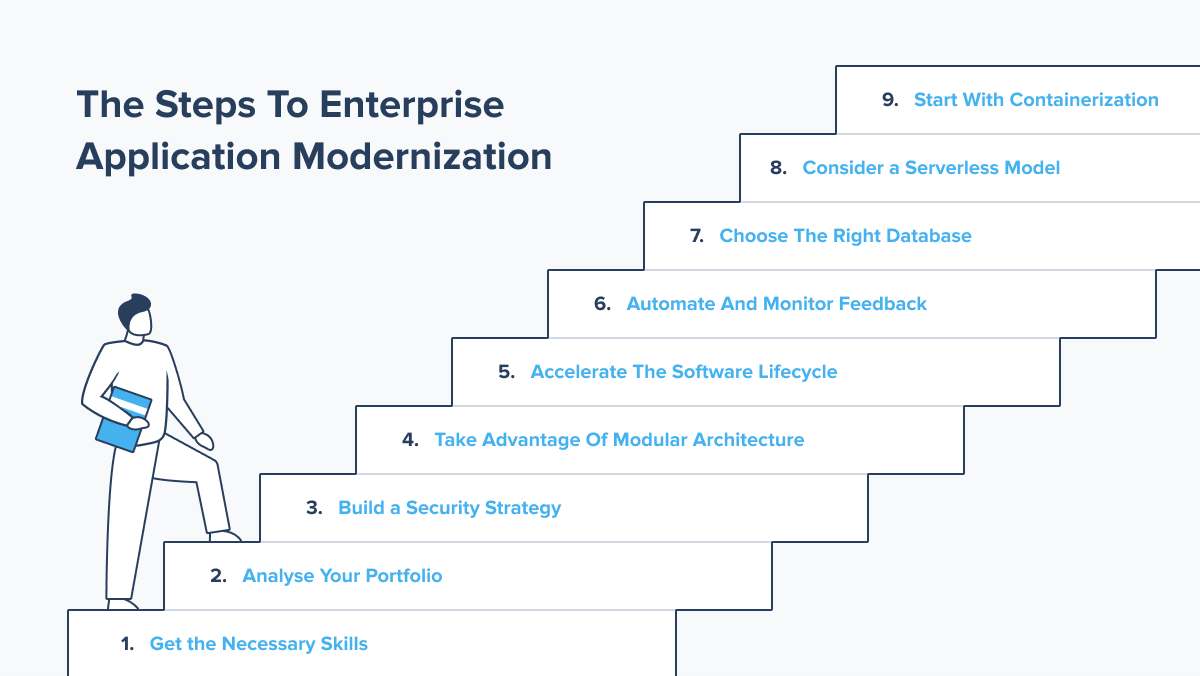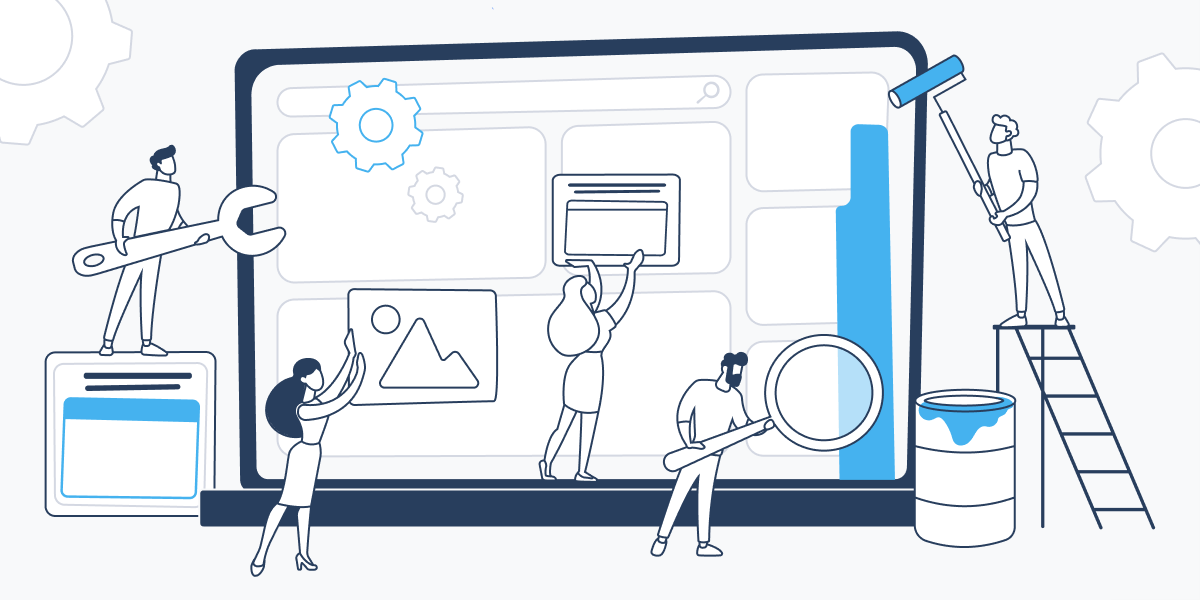Introduction
You will be hard-pressed to find a company that does not think about digital transformation at some level or does not make it a strategic priority – there is almost no chance that you’ll find one. A study conducted by IBM showed that upgrading existing applications and infrastructure are the tactical objectives of digital transformation for more than 43% of companies. As a result, the global application modernization market is expected to grow to $24.8 billion by 2025.
Why You Have To Modernize Your Enterprise Application
Why is it urgent to upgrade enterprise applications? The simple explanation is a lack of agility. A typical organisation’s application stack consists of a diverse mix of on-site apps and cloud apps such as CRM, ERP, HCM, and other custom solutions.
It is a tremendous, if not impossible task to implement digital transformation initiatives if business-critical applications are running in isolation in your organisation. Application integration drives modernization by connecting applications to provide a unified view of business operations, processes, and systems. This not only helps the business meet the requirements of an ever-changing market, but also ensures smooth integration and coordination between cloud and on-site applications. Otherwise, data is isolated and disconnected.
Regardless of your size or industry, you must adapt quickly to new challenges or risk failure among competitors. In recent years, retailers have had to suddenly change their business models to offer online shopping, delivery, and pickup. Manufacturers had to quickly rebuild their supply chain to cover gaps in the procurement of raw materials. And educational institutions needed to immediately connect their campuses and students to digital technologies in order to provide distance learning. Today, many industry leaders are surprised at how quickly they had to act. It all came down to the ability to successfully respond to changes. That’s what agility means.
Recently, we published an article called Innovative Application Modernization Strategies to Consider in 2022 on our blog. There you can choose an application modernization strategy that fits your business best, as well as find more statistics about the application modernization market.
The Steps To Enterprise Application Modernization

Due to the technical debt that has accumulated in organisations over the years, there is a problem with prioritising tasks and allocating the necessary personnel and budget for modernization. The long-term benefits of applications built on a modern cloud architecture provide flexibility at a lower cost, which frees up budgets to further accelerate modernization.
So, here are some steps that need to be taken for enterprise app modernization.
Finding Or Developing The Necessary Skills
Many organisations experience a significant shortage of employees with knowledge of modern enterprise architecture, consisting of functions, containers, and microservices. Corporate development teams may not have the competence to understand how to write new stateless applications without technologies focused on virtual machines.
Operational teams need to set up sophisticated monitoring and logging systems, which will lead to automatic problem-solving in real time. Just a small part of employees are well acquainted with new development technologies. Cultural changes are needed to adapt to the new way of delivering applications, which requires a workforce familiar with all aspects of the benefits that modern cloud technologies can provide.
Analyse Your Portfolio
Enterprise application modernization is a process that begins with an analysis of the existing portfolio to ensure that the solutions that provide the greatest value to the organisation meet the business needs. Some applications have components that are more suitable for using cloud technologies, and they should be identified and divided into microservices. When solutions face spikes in demand, they are good candidates for refactoring into microservices.
Some functions need to be increased and decreased, some will have to be isolated from the rest of the monolithic application. Planning for integration with an existing portfolio is important to ensure that legacy applications can cope with the requirements of refactored applications. Prioritising applications where the return on investment from refactoring efforts can be implemented early helps establish confidence and momentum.
Build a Security Strategy
While time to market and application deployment speeds are important, building a pipeline with security checkpoints throughout the development and deployment lifecycle is critical to success. Regulatory requirements and compliance guidelines require closely following data sovereignty and confidentiality conditions. Applying common security features to all factoring applications ensures reuse and reduces overall effort.
Since modern application architecture depends on individual services connected via application programming interfaces (APIs), a security policy that combines the Identity and Access Management (IAM) infrastructure with an API gateway is essential for data and application security. An end-to-end security policy can provide secure communication between new and monolithic or packaged API-enabled applications.
Take Advantage Of Modular Architecture
Microservices are changing the course of software development, as developers create independent services connected via APIs. Being independent and specialised, microservices provide a number of advantages, including reusability, a better ability to cope with scaling, and reduced development time.
Application modules decomposed into separate autonomous microservices can be called independently from each other using APIs that allow for smooth integration with existing applications. Enterprises should evaluate circumstances that improve application capabilities, such as improved horizontal scaling, and also consider data synchronization issues that may arise during decoupling.
Decomposing applications into microservices with their own data storage will ensure continuous delivery. Application separation provides scalability by accessing only the resources that are in high demand, for example, in a certain geography.
Recently, we wrote the article “Monolith vs Microservices: Everything You Need To Know”. Feel free to read it to learn more about the benefits of modular architecture!
Accelerate The Software Lifecycle
Development processes around containers, microservices, and functions are constantly evolving and speeding up the path from source code management to deployment. Adopting the DevOps model increases flexibility and responsiveness to application feature requests. All stages of the pipeline, including testing and packaging, must be automated using scripts.
Automate And Monitor Feedback
When automating the pipeline (which includes the build, test, and deployment stages) it is important to monitor the process and to provide the developer with immediate feedback in case of any failure. Feedback allows you to identify the areas that have room for improvement and steps that can be automated in the future.
Choose The Right Database
When choosing an appropriate database type to manage the scale, security, and availability of a distributed application, you have several different options. Relational databases, graph databases, key-value pairs, and time series databases are some of the database types available to support use cases ranging from e-commerce applications, gaming, geospatial data, and the Internet of Things (IoT). Open-source database instances reduce costs, and in-memory caching services provide the ability to handle large volumes of requests from mobile and web applications.
Consider a Serverless Model
Serverless technologies simplify infrastructure management and provide built-in high availability, allowing developers to focus on writing business logic in the language of their choice. Payment is measured in units of work and is estimated by the duration of execution, which can automatically increase and decrease, leading to a decrease in the total cost of ownership.
The adoption of a serverless operating model allows developers to focus on the main tasks, shifting work that does not add value to the cloud service provider. Consider a cold start when evaluating a serverless model. The time it takes to initialize “cold” functions can be a problem for applications that require rapid scaling, although many vendors offer solutions to this problem using pre-warmed functions.
As serverless technologies evolve to solve cold start problems and awareness of the new development architecture grows, more and more enterprises are selecting serverless architecture as the first choice when developing applications.
Try To Start With Containerization
Cloud services allow the provider to take on most of the responsibility for the infrastructure at different levels, which saves the user from having to deal with the complexities of managing those workloads. For container-based applications, cloud service providers manage clusters, and for event-driven applications, they manage the entire backend. IoT and streaming processing applications are ideal for event-driven computing. An increasing number of companies are choosing serverless solutions as the main option for all new applications, which gives them an advantage over competitors.
Conclusion
Regardless of the industry or market, every application requires modernization in order not to lose the competition. That is why enterprise application modernization has such massive potential. The need to adapt to new conditions, as well as the lack of flexibility, can lead not only to the loss of users, but also to significant financial losses. Therefore, it is very important to monitor emerging technologies and their usage possibilities when upgrading applications.
However, thoughtless implementation of new technologies can lead to the collapse of the entire system. That is why it is so important to find a software development company that is familiar with these technologies. Bamboo Agile can become a worthy partner on the way to modernizing the application for your business. Simply contact us to get a free consultation about your project and entrust it to our specialists.



